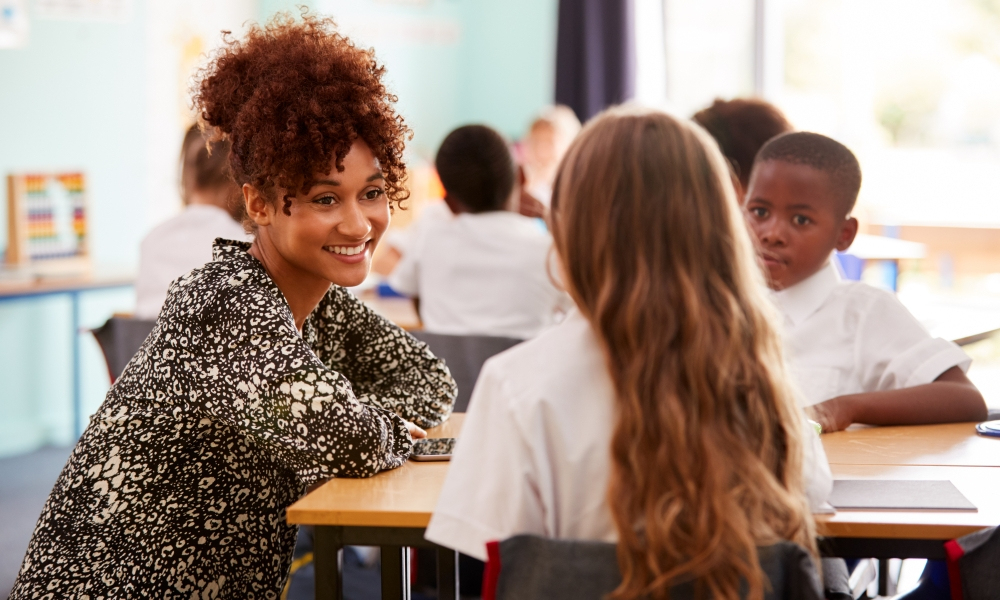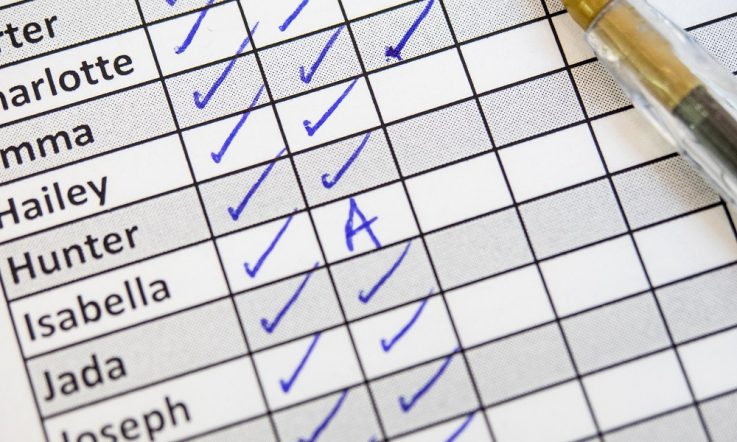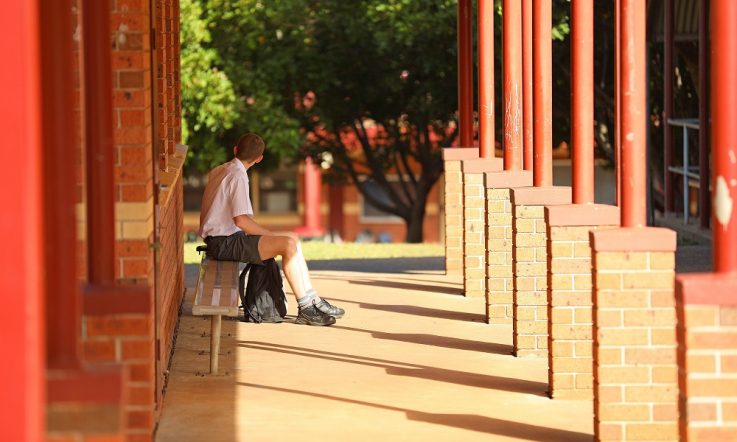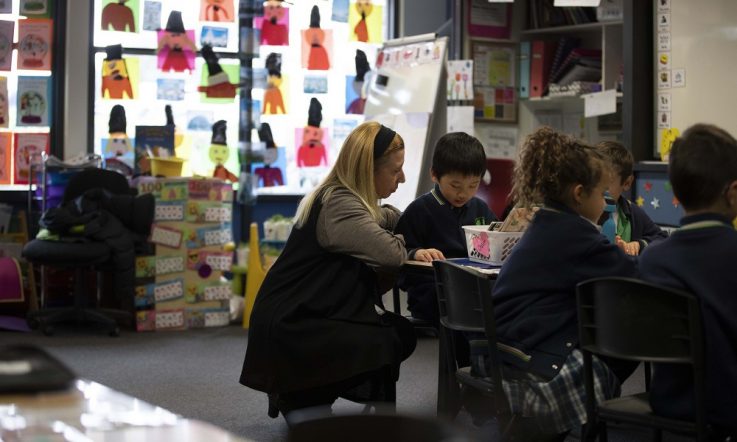Thanks for downloading this podcast from Teacher magazine. I'm Dominique Russell.
Childhood and adolescent anxiety is something many classroom teachers will come face-to-face with, so it's important to understand what a teacher's role could be in identifying and managing anxiety. Are there behaviours a teacher could be observing in the classroom that might be typical of anxiety? How can a classroom educator help to reinforce the work of a student's psychologist or therapist? And, what can teachers do to make their classroom more comfortable and accommodating for students experiencing anxiety?
To discuss all of this, I'm joined in today's episode by Dr Rowena Conroy, a clinical psychologist who works with children, adolescents and families at the Children's Private Medical Group in Victoria. We sat down together at the National Education Summit in Melbourne after her presentation on student anxiety.
Let's start off by hearing Rowena explain what an anxiety disorder is and why it can develop.
Dr Rowena Conroy: So childhood anxiety – or even anxiety at all ages – a couple of points to make is that anxiety is certainly a very normal emotional experience. We all experience anxiety from time to time and, in fact, it's very helpful and adaptive at certain times for us to experience the changes and reactions that go along with feeling anxious.
… We think there are a number of factors that might contribute to the development of anxiety. So, certainly we know that anxiety runs in families and we understand there to be a genetic component to that. We also know that experiencing certain life events – like stressful and traumatic experiences – can lead to the development of anxiety, but also that many children will develop anxiety in the absence of significant stressful or traumatic events.
… Everybody experiences anxiety and that includes all children and adolescents. What we use to determine, I guess, whether somebody has an anxiety disorder is really the frequency and the intensity of their anxiety and perhaps, most importantly, the impact that anxiety is having on them in their daily life. So, if anxiety is stopping a young person from doing the sorts of things that we would expect them to be doing and their age or stage of life, and causing them significant distress or impairment in that way, we would consider whether they may meet criteria for an anxiety disorder, if that were a persistent pattern of difficultly over an extended period.
DR: Now it's also really common for the body to physically react to anxiety. People experiencing anxiety might also display certain behaviours. Here, Rowena delves into what exactly anxiety can look like.
RC: So, anxiety can look like lots of different things for lots of different children. [And so] individual children and teenagers, will show us that they're feeling different in all sorts of different ways. I think one of the most important things for us to remember is that it's not always the case that they'll immediately tell us about their worries or fears, but we might instead learn about their anxiety, or know about their anxiety, through some of their behaviours.
We often think of anxiety as having three different components. So we're often aware ourselves of the sorts of things that children with anxiety also experience, which is the physical reactions of anxiety, sometimes we refer to this as the ‘fight or flight response'. Things like a racing heart, or fast breathing, sometimes feeling sweaty or hot, shaky, those sorts of physical reactions can go along with anxiety.
Children who experience anxiety also display certain kinds of thinking patterns, so they tend to see the world in a way that … they are quite tuned into threat and danger. So they tend to, we might describe it as, overestimating the amount of threat that there is in the world, relative to the actual, or objective level, of threat.
And then that third component of anxiety is the behavioural component. And it's often that behavioural component that's the most obvious to us when we're working with children. And, broadly speaking, those behaviours are characterised by what we might describe as ‘avoidance' and/or ‘escape'.
So children and teens with anxiety will tend to avoid situations that they anticipate may make them anxious. They might also engage in more subtle forms of avoidance. So that avoidance might be something really obvious, like not going to school, or not sleeping in their own bed. But we sometimes also talk about a subtle or a covert form of avoidance – sometimes referred to in the literature as a ‘safety behaviour', where children might do certain, other kinds of behaviours to prevent them from feeling anxious. And a good example of this might be a high level of perfectionism where a student might have a fear of making a mistake. And so what they do is lots of checking of their work and spending extra time on their homework and extra time on their assignments, just to make sure they don't make a mistake. In a way we'd see that perfectionism as an avoidance behaviour, because it's avoiding, they're avoiding the thing they fear most – which is being wrong or making a mistake.
DR: So, now that we understand what anxiety is and how it can present in students in the classroom, what role can teachers have in identifying anxiety?
RC: Yeah, so I think there's a really important role there for educators potentially being able to identify children experiencing anxiety and, as appropriate, facilitate, help and referrals [if that help] is not already in place, as well as the management side of things. And, potentially, from a prevention point of view, teachers are often meeting children at a young age and there's exciting opportunities there to potentially prevent the development of anxiety there as well.
From the point of identification, I think that teachers are in a really good position to notice signs of anxiety in children in that they're seeing them day in, day out, completing a range of different tasks that might often elicit anxiety in children. So they're an important source of observation in that regard.
And, in terms of what are the things for teachers to be looking out for?
I think they're some of those things that we would have talked about as being the key indicators of anxiety at large. So, for teachers to look out for children expressing that they're feeling very fearful or worried about something; if they notice a child avoiding a particular kind of task or even avoiding school on a particular day when certain kinds of tasks are going to be completed.
Or there might be other ways in which teachers notice students' anxieties, such as the ways they are approaching their work. So they might be reluctant about doing their work independently, but instead doing lots of reassurance seeking and checking in with the teacher about whether they're doing things right. They might be checking their own work a lot and being somewhat, what we might describe as ‘perfectionistic' about the way that they're approaching their work.
So, I think all of those behaviours could be different kinds of signs that teachers might see that children are experiencing anxiety in the school setting.
DR: So, Rowena touched on perfectionism right there. Here, she delves into that idea a little bit more, and how perfectionism is often misinterpreted in an education setting.
RC: Yeah, it's a word that we throw around quite a lot, isn't it, and describe it as a trait. And sometimes I think even people describe it as quite a positive personality trait, or understand it to be describing somebody who's got good attention to detail, or who really likes to make sure everything's just right. But, when we're seeing perfectionism in the context of anxiety disorders or anxiety problems, it can actually represent … a factor that's really significantly getting in the way of the young person overcoming their anxiety.
So, for anxious children, being perfectionistic – so really trying to perhaps check over things over and over and over again to make sure they're right, or looking a lot at the detail of their work, those sorts of things that we might ascribe to perfectionism. For anxious children, those are really, in ways, representing, if you like, a way of those children avoiding their biggest fear, which is the fear of making a mistake or the fear of doing something imperfectly.
What we know about recovering from anxiety, or managing anxiety, is that in fact … one of the most helpful things for us to do is to help children to face their fears rather than avoid them. And so, if they can face that fear of making a mistake by perhaps see they're [teachers] encouraging mistake making and really promoting an atmosphere where that's okay. Or helping children [and teenagers] to minimise that checking, or minimise some of those behaviours, we might be doing a very helpful thing for them by helping them really confront that thing that they're most afraid of and learning that they can cope with it.
DR: So, let's get into an educator's important and positive role in managing anxiety. Rowena says teachers can be in a position to reinforce the work of a student's psychologist or therapist, and she explains that here.
RC: Current evidence would tell us that best practice – in terms of psychological treatments for anxiety – is something that we call cognitive behavioural therapy, or CBT. And CBT has a number of components.
CBT for a young person with a psychologist would involve things like a big focus on facing their fears, confronting their fears without engaging in some of those avoidance behaviours that we've talked about. It might involve helping them to look at the way that they're viewing and seeing and thinking about the world. And perhaps to have a focus on what we would describe as ‘realistic thinking', or ‘helpful thinking', where we would encourage children who are getting stuck on perhaps seeing the worst case scenario, or engaging in a catastrophic way of thinking, we'd encourage those children to learn how to look at what we might call the evidence for those thoughts, or look at whether there might be other ways they could view a situation that are not so catastrophic.
And cognitive behavioural therapy, or CBT, for anxiety also involves a big role for working with parents and helping parents to think about how they might be able to encourage brave behaviours and respond to their children when they're seeking reassurance or engaging in avoidance.
Teachers can play a really important part in reinforcing that work, because CBT is quite a skills-focused therapy approach, which means students or children will be learning skills in the session with their therapist or psychologist, but then being asked to do some practice later on at home or at school, some practice of those skills that they've been learning.
So, if teachers are in contact with the psychologist or the therapist and they know what the child's been learning they may well be able to help them do some of the things that I just mentioned. So help them perhaps to develop a bit of a stepladder for gradually facing their fears, help students to do some of that realistic or helpful thinking that we've talked about. So I think there's a big role that teachers can play there.
DR: Another behaviour that's really common with people who have anxiety is reassurance seeking, which we've touched on briefly. So here, Rowena gives a really great example of how to respond to a student consistently asking ‘is this right?' about their work.
RC: Children with anxiety often do, do a lot of reassurance seeking and this can look like asking lots of questions of their parents, of their teachers. Questions about things that are coming up, sometimes questions about ‘what ifs' and ‘whys' as well. And we would understand this in children with anxiety, if they're engaging in this excessive questioning and reassurance seeking, we would understand it as their way of perhaps trying to alleviate their anxiety about uncertainty. We know that children with anxiety disorders often don't like not knowing, or don't like uncertainty, so their questioning or their reassurance seeking can at times represent their effort to try and stop being in that position of being unsure.
In terms of what it may be helpful to do, I think just tuning into that is probably one of the first steps for teachers. Sometimes it can seem like a really positive and conscientious behaviour if students are asking lots of questions of a teacher, so just holding in mind that for students with anxiety it might represent their effort to cope. What we'd like them to be able to do, of course, is learn that they can cope with uncertainty without having to get that reassurance from a teacher.
On a really practical level, [if a student] were asking a question of a teacher about their work – perhaps they were asking the teacher ‘is this right?' ‘Have I got this right?' ‘Am I doing it right?' The teacher might be able, instead of just saying ‘yes' or ‘good job, you're doing it right', perhaps the teacher could respond in a way that helps the student to learn to cope a little bit more independently with that situation. So, maybe encourage them to, they could say ‘go back, why don't you go back and have a look at what the question was and see if you're answering all the parts of the question that are there'. Something along those lines might then help the child to learn some different ways of coping when they're feeling uncertain in that way.
DR: Now, Rowena and I spoke about a particular scenario that could be quite relevant to a lot of teachers. She used the example of a parent of a student being late to pick them up and the student, who might be having anxiety problems, would immediately go to catastrophic thinking. They might think that something awful has happened to their parent. So here, Rowena is going to explain that when a student comes to you with this problem, it's quite common to want to reassure them straight away. However, it could be more constructive and beneficial for the student for educators to invite more realistic thinking from them.
RC: Yeah, you're absolutely right. It's often our inclination or our tendency to want to reassure a child who's expressing a worry like that. And, indeed, it's likely to be what we believe, is that their mum is okay. But, what we suggest that might be helpful for children – and this is what we as psychologists will do in their therapy with children around anxiety, but also where there's a bit of scope, I think, for teachers to help children in this way in their natural daily conversations – which is to really help children to, perhaps, themselves start to question those thoughts and have a look at those thoughts and whether those thoughts that they're having might be what we describe as a little bit catastrophic. And, therefore, to perhaps be able to think about some of the different possible interpretations of that situation.
So to think about whether it's possible that mum might actually be running late, or that her car might have broken down, or that she might have bumped into somebody that she knows and had a chat along the way. So, if teachers are able to help children to perhaps open up their minds to flexibly think about all the different possible explanations rather than just focusing in on the explanation that suggests threat or danger; that might be helping children to learn a really important skill that they can use later on themselves.
DR: Rowena and I also spoke about how a teacher can work towards creating a comfortable and accommodating classroom environment for students experiencing anxiety. Here, she explains why normalising anxiety can be really helpful.
RC: I think there are a number of things that teachers can do in terms of perhaps the atmosphere or the culture that they're creating. One of the biggest ones is just to normalise discussion about anxiety and fear. So, to have open discussion from time to time about the different fears that we all have, given anxiety and fear are such a normal part of life. And so being really sort of open and normalising about the concept that these are really normal parts of the human experience, I think can be really helpful.
I think that another thing that teachers can do is provide, or serve as really good role models for students around how to approach things if things do perhaps not go to plan or if something unexpected or difficult happens to model themselves that they're able to be flexible, or stay calm, or not catastrophise. Or that if teachers can model more of that approach and less of that avoidance behaviour, they're again setting a really helpful example for students.
The other thing that I think teachers can do, both for individual students struggling with anxiety, but also for the class as a whole, is to pay attention to what we might describe as ‘brave behaviours' or ‘approach behaviours'. So, if they're noticing students pushing themselves a little bit outside of their comfort zone, they might well want to provide some comment on that, provide some praise, provide some attention for that. Or even set some tasks for some students that allow them to do that in a more deliberate way.
And when we talk about praising I think an important concept for us to remember is that we're praising students for facing their fears or their worries, rather than praising them for perhaps not crying or not getting upset, but instead it's the behaviour or the facing the fear that's what we're praising.
DR: And finally, is there anything that can be done at a whole-school, policy level to be mindful of children and adolescents experiencing anxiety? Rowena thinks there is, and says there's an opportunity for school communities to promote brave behaviour when it comes to encountering things they might be fearful of.
RC: So I think one of the themes that we've been talking about a little bit is this idea of being mindful of not promoting avoidance, or not joining with anxious children in their avoidance. And so it may be helpful for schools to have a look at whether at a broader, sort of policy and practice level, whether there's anything that's going on within the school environment that is promoting that avoidance. And likewise, I guess, then whether there are any changes that can be made that are more around helping to promote that brave, approach-focused behaviour that we've been talking about as allowing for children to really have the experience of learning that they can cope.
That's all for this episode. To access the full transcript for this podcast, head to teachermagazine.com.au. That's where you'll also find all of our articles, videos and infographics for free. While you're there, be sure to sign up to the Teacher Bulletin to have our new content delivered straight to your inbox.
Dr Rowena Conroy says it can be useful for teachers to encourage students who tend to seek reassurance often to be more independent in their thinking.
As an educator, how do you usually respond to the repeated question of ‘is this right?’ from a student? Is there room to make your response more constructive?



